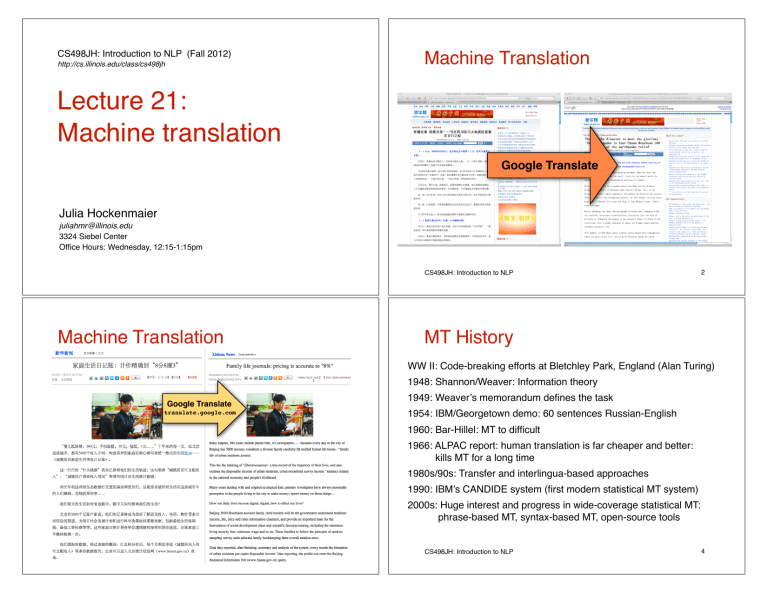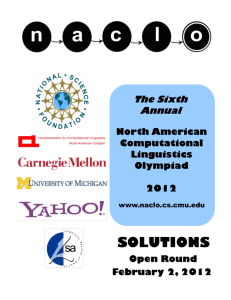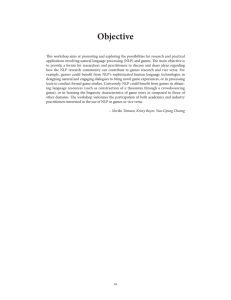Lecture 21: Machine translation
advertisement

CS498JH: Introduction to NLP (Fall 2012)
Machine Translation
http://cs.illinois.edu/class/cs498jh
Lecture 21:
Machine translation
Google Translate
Julia Hockenmaier
juliahmr@illinois.edu
3324 Siebel Center
Office Hours: Wednesday, 12:15-1:15pm
CS498JH: Introduction to NLP
Machine Translation
2
MT History
WW II: Code-breaking efforts at Bletchley Park, England (Alan Turing)
1948: Shannon/Weaver: Information theory
1949: Weaver’s memorandum defines the task
Google Translate
1954: IBM/Georgetown demo: 60 sentences Russian-English
translate.google.com
1960: Bar-Hillel: MT to difficult
1966: ALPAC report: human translation is far cheaper and better:
kills MT for a long time
1980s/90s: Transfer and interlingua-based approaches
1990: IBM’s CANDIDE system (first modern statistical MT system)
2000s: Huge interest and progress in wide-coverage statistical MT:
phrase-based MT, syntax-based MT, open-source tools
CS498JH: Introduction to NLP
3
CS498JH: Introduction to NLP
4
The Rosetta Stone
Three different translations of the same text:
- Hieroglyphic Egyptian (used by priests)
- Demotic Egyptian (used for daily purposes)
- Classical Greek (used by the administration)
Instrumental in our understanding of ancient Egyptian
This is an instance of parallel text:
The Greek inscription allowed scholars
to decipher the hieroglyphs
CS498JH: Introduction to NLP
5
CS498JH: Introduction to NLP
6
Some examples
John loves Mary.
Jean aime Marie.
Why is MT difficult?
John told Mary a story.
Jean a raconté une histoire à Marie.
John is a computer scientist.
Jean est informaticien.
John swam across the lake.
Jean a traversé le lac à la nage.
CS498JH: Introduction to NLP
7
CS498JH: Introduction to NLP
8
Correspondences
Correspondences
John loves Mary.
One-to-one:
John = Jean, aime = loves, Mary=Marie
Jean aime Marie.
One-to-many/many-to-one:
John told Mary a story.
Mary = [à Marie]
[a computer scientist] = informaticien
Jean [a raconté] une histoire [à Marie].
Many-to-many:
John is a [computer scientist].
[swam across
Jean est informaticien.
à la nage]
Reordering required:
told Mary1 [a story]2 = a raconté [une histoire]2 [à Marie]1
John [swam across] the lake.
Jean [a traversé]
] = [a traversé
le lac [à la nage].
9
CS498JH: Introduction to NLP
Lexical divergences
10
Lexical divergences
- The different senses of homonymous words
Lexical specificity
generally have different translations:
English-German: (river) bank - Ufer
CS498JH: Introduction to NLP
German Kürbis = English pumpkin or (winter) squash
English brother = Chinese gege (older) or didi (younger)
(financial) bank - Bank
- The different senses of polysemous words
Morphological divergences
English: new book(s), new story/stories
French: un nouveau livre (sg.m), une nouvelle histoire (sg.f),
des nouveaux livres (pl.m), des nouvelles histoires (pl.f)
may also have different translations:
I know that he bought the book: Je sais qu’il a acheté le livre.
I know Peter:
Je connais Peter.
I know math:
Je m’y connais en maths.
- How much inflection does a language have?
(cf. Chinese vs.Finnish)
- How many morphemes does each word have?
- How easily can the morphemes be separated?
CS498JH: Introduction to NLP
11
CS498JH: Introduction to NLP
12
Syntactic divergences
Syntactic divergences: negation
Word order: fixed or free?
Normal
Negated
English
I drank coffee.
I didn’t drink (any) coffee.
do-support,
any
French
J’ai bu du café
Je n’ai pas bu de café.
ne..pas
du -> de
German
Ich habe Kaffee
getrunken
Ich habe keinen Kaffee
getrunken
keinen Kaffee
=
‘no coffee’
If fixed, which one? [SVO (Sbj-Verb-Obj), SOV, VSO,… ]
Head-marking vs. dependent-marking
Dependent-marking (English)
Head-marking (Hungarian)
the man’s house
the man house-his
Pro-drop languages can omit pronouns:
Italian (with inflection): I eat = mangio; he eats = mangia
Chinese (without inflection): I/he eat: chīfàn
CS498JH: Introduction to NLP
13
CS498JH: Introduction to NLP
14
Semantic differences
Aspect:
- English has a progressive aspect:
‘Peter swims’ vs. ‘Peter is swimming’
An exercise
- German can only express this with an adverb:
‘Peter schwimmt’ vs. ‘Peter schwimmt gerade’
Motion events have two properties:
- manner of motion (swimming)
- direction of motion (across the lake)
Talmy: Languages express either the manner with a verb and
the direction with a ‘satellite’ or vice versa:
English (satellite-framed): he [swam]MANNER [across]DIR the lake
French (verb-framed):
il a [traversé]DIR le lac [à la nage]MANNER
CS498JH: Introduction to NLP
15
CS498JH: Introduction to NLP
16
Knight’s Centauri and Arctuan
1a. ok-voon ororok sprok.
1b. at-voon bichat dat.
2a. ok-drubel ok-voon anok plok sprok.
2b. at-drubel at-voon pippat rrat dat.
3a. erok sprok izok hihok ghirok.
3b. totat dat arrat vat hilat.
4a. ok-voon anok drok brok jok.
4b. at-voon krat pippat sat lat.
5a. wiwok farok izok stok.
5b. totat jjat quat cat.
6a. lalok sprok izok jok stok.
6b. wat dat krat quat cat.
The original corpus
7a. lalok farok ororok lalok sprok izok
enemok.
7b. wat jjat bichat wat dat vat eneat.
8a. lalok brok anok plok nok.
8b. iat lat pippat rrat nnat.
3a. his associates are not strong.
3b. sus asociados no son fuertes.
10a. the modern groups sell strong
pharmaceuticals.
10b. los grupos modernos venden medicinas
fuertes.
10a. lalok mok nok yorok ghirok clok.
10b. wat nnat gat mat bat hilat.
5a. its clients are angry.
5b. sus clientes están enfadados.
11a. lalok nok crrrok hihok yorok
zanzanok.
11b. wat nnat arrat mat zanzanat.
6a. the associates are also angry.
6b. los asociados tambien están enfadados.
17
Both corpora
CS498JH: Introduction to NLP
9a. its groups are in Europe.
9b. sus grupos están en Europa.
4a. Garcia has a company also.
4b. Garcia tambien tiene una empresa.
CS498JH: Introduction to NLP
8a. the company has three groups.
8b. la empresa tiene tres grupos.
2a. Carlos Garcia has three associates.
2b. Carlos Garcia tiene tres asociados.
9a. wiwok nok izok kantok ok-yurp.
9b. totat nnat quat oloat at-yurp.
12a. lalok rarok nok izok hihok mok.
12b. wat nnat forat arrat vat gat.
1a. Garcia and associates.
1b. Garcia y asociados.
2a. Carlos Garcia has three associates.
2b. Carlos Garcia tiene tres asociados.
3a. his associates are not strong.
3b. sus asociados no son fuertes.
4a. Garcia has a company also.
4b. Garcia tambien tiene una empresa.
5a. its clients are angry.
5b. sus clientes están enfadados.
6a. the associates are also angry.
6b. los asociados tambien están enfadados.
7a. the clients and the associates are enemies.
7b. los clientes y los asociados son enemigos.
8a. the company has three groups.
8b. la empresa tiene tres grupos.
9a. its groups are in Europe.
9b. sus grupos están en Europa.
10a. the modern groups sell strong pharmaceuticals.
10b. los grupos modernos venden medicinas fuertes.
11a. the groups do not sell zanzanine.
11b. los grupos no venden zanzanina.
12a. the small groups are not modern.
12b. los grupos pequeños no son modernos.
1a. Garcia and associates.
1b. Garcia y asociados.
11a. the groups do not sell zanzanine.
11b. los grupos no venden zanzanina.
12a. the small groups are not modern.
12b. los grupos pequeños no son modernos.
7a. the clients and the associates are enemies.
7b. los clientes y los asociados son enemigos.
18
CS498JH: Introduction to NLP
Both corpora
1a. ok-voon ororok sprok.
1b. at-voon bichat dat.
2a. ok-drubel ok-voon anok plok sprok.
2b. at-drubel at-voon pippat rrat dat.
3a. erok sprok izok hihok ghirok.
3b. totat dat arrat vat hilat.
4a. ok-voon anok drok brok jok.
4b. at-voon krat pippat sat lat.
5a. wiwok farok izok stok.
5b. totat jjat quat cat.
6a. lalok sprok izok jok stok.
6b. wat dat krat quat cat.
7a. lalok farok ororok lalok sprok izok enemok.
7b. wat jjat bichat wat dat vat eneat.
8a. lalok brok anok plok nok.
8b. iat lat pippat rrat nnat.
9a. wiwok nok izok kantok ok-yurp.
9b. totat nnat quat oloat at-yurp.
10a. lalok mok nok yorok ghirok clok.
10b. wat nnat gat mat bat hilat.
11a. lalok nok crrrok hihok yorok zanzanok.
11b. wat nnat arrat mat zanzanat.
12a. lalok rarok nok izok hihok mok.
12b. wat nnat forat arrat vat gat.
1a. Garcia and associates.
1b. Garcia y asociados.
2a. Carlos Garcia has three associates.
2b. Carlos Garcia tiene tres asociados.
3a. his associates are not strong.
3b. sus asociados no son fuertes.
4a. Garcia has a company also.
4b. Garcia tambien tiene una empresa.
5a. its clients are angry.
5b. sus clientes están enfadados.
6a. the associates are also angry.
6b. los asociados tambien están enfadados.
7a. the clients and the associates are enemies.
7b. los clientes y los asociados son enemigos.
8a. the company has three groups.
8b. la empresa tiene tres grupos.
9a. its groups are in Europe.
9b. sus grupos están en Europa.
10a. the modern groups sell strong pharmaceuticals.
10b. los grupos modernos venden medicinas fuertes.
11a. the groups do not sell zanzanine.
11b. los grupos no venden zanzanina.
12a. the small groups are not modern.
12b. los grupos pequeños no son modernos.
19
CS498JH: Introduction to NLP
1a. ok-voon ororok sprok.
1b. at-voon bichat dat.
2a. ok-drubel ok-voon anok plok sprok.
2b. at-drubel at-voon pippat rrat dat.
3a. erok sprok izok hihok ghirok.
3b. totat dat arrat vat hilat.
4a. ok-voon anok drok brok jok.
4b. at-voon krat pippat sat lat.
5a. wiwok farok izok stok.
5b. totat jjat quat cat.
6a. lalok sprok izok jok stok.
6b. wat dat krat quat cat.
7a. lalok farok ororok lalok sprok izok enemok.
7b. wat jjat bichat wat dat vat eneat.
8a. lalok brok anok plok nok.
8b. iat lat pippat rrat nnat.
9a. wiwok nok izok kantok ok-yurp.
9b. totat nnat quat oloat at-yurp.
10a. lalok mok nok yorok ghirok clok.
10b. wat nnat gat mat bat hilat.
11a. lalok nok crrrok hihok yorok zanzanok.
11b. wat nnat arrat mat zanzanat.
12a. lalok rarok nok izok hihok mok.
12b. wat nnat forat arrat vat gat.
20
The Vauquois triangle
Interlingua
is
ys
Semantics
An
n
io
at
al
Semantics Semantic transfer
r
ne
Ge
Machine translation
approaches
Syntax
Words
Syntactic transfer
Syntax
Direct transfer
Words
Transfer
Source
CS498JH: Introduction to NLP
21
CS498JH: Introduction to NLP
Target
22
Limits of direct translation:
Phrasal reordering
Direct translation
Maria non dió una bofetada a la bruja verde.
Adverb placement in German:
1. Morphological analysis of source string
Maria nonNeg dar3sgF-Past una bofetada a la bruja verde
The green witch is at home this week.
(usually, a complete morphological analysis)
Diese Woche ist die grüne Hexe zuhause.
2. Lexical transfer (using a translation dictionary):
Mary not slap3sgF-Past to the witch green.
Japanese SOV order:
He
3. Local reordering:
Mary not slap3sgF-Past the green witch.
adores listening to music
Kare ha ongaku wo kiku no ga daisuki desu
PPs in Chinese:
Jackie Cheng went to Hong Kong
4. Morphology:
Mary did not slap the green witch.
CS498JH: Introduction to NLP
Cheng Long dao Xianggang qu
23
CS498JH: Introduction to NLP
24
Syntactic transfer
Semantic transfer
Requires a syntactic parse of the source language,
followed by reordering of the tree
Done at the level of predicate-argument structure
(some people call this syntactic transfer too…):
Local reordering:
Noun
Adj
Noun
N
N
green witch
Adj
bruja verde
or at the level of semantic representations (e.g. DRSs):
Nonlocal reordering:
S
NP
S
VP
The green witch V
PP
PP
is at home this week
PP
V
NP
PP
diese Woche ist die grüne Hexe zuhause
25
CS498JH: Introduction to NLP
Interlingua approaches
Dorna et al. 1998
26
CS498JH: Introduction to NLP
Statistical MT
Parallel corpora
- Based on the assumption that there is a common meaning
representation language (e.g. predicate logic) that abstracts
away from any difference in surface realization
MOTION: PRESIDENT (in Cantonese): Good
morning, Honourable Members. We will now start
the meeting. First of all, the motion on the
- Was thought useful for multilingual translation
Translation Model
- Often includes ontologies
Ptr(
| morning)
Monolingual corpora
Good
morning, Honourable
Members.
We
will now
start the
Good
Honourable
Members.
We
the
Goodmorning,
morning,
Honourable
Members.
Wewill
willnow
nowstart
the
meeting.
First
ofofall,
the
motion
ononthe
"Appointment
ofstart
meeting.
First
all,
the
motion
the
"Appointment
ofthe
meeting.
First
of
all,
the
motion
on
the
"Appointment
ofthe
the
Chief
Justice
ofofthe
Court
ofofFinal
Appeal
ofofthe
Hong
Kong
Chief
Justice
the
Court
Final
Appeal
the
Hong
Kong
ChiefAdministrative
Justice of the Court
of Final
Appeal
ofJustice.
the Hong Kong
Special
Region".
Secretary
for
Special
SpecialAdministrative
AdministrativeRegion".
Region".Secretary
Secretaryfor
forJustice.
Justice.
Language Model
Plm(honorable | good morning)
Input
Translation
Decoding algorithm
President: Good
morning, Honourable
Members.
Leavitt et al. 1994
CS498JH: Introduction to NLP
27
CS498JH: Introduction to NLP
28
The noisy channel model
Translating from Chinese to English:
argmaxEng P(Eng|Chin) = argmaxEng P(Chin|Eng)
⇤
⇥
⌅
Translation Model
English
Input I
Noisy
Channel
P(O | I)
Foreign
Output O
Guess of
English Input Î
P(Eng)
⇤ ⇥ ⌅
LanguageModel
Decoder
(Translating to
English)
Î = argmaxI P(O|
I)P(I)
29
CS498JH: Introduction to NLP
The noisy channel model
Translating from Chinese to English:
argmaxEng P(Eng|Chin) = argmaxEng P(Chin|Eng)
⇤
⇥
⌅
Translation Model
English
Input I
Noisy
Channel
P(O | I)
30
CS498JH: Introduction to NLP
The noisy channel model
This is really just an application of Bayes’ rule:
P(Eng)
⇤ ⇥ ⌅
Ê
LanguageModel
=
arg max P (E|F )
=
arg max
=
Foreign
Output O
E
P (F |E) ⇥ P (E)
E
P (F )
arg max
P (F |E)
⇥
E
| {z }
Translation Model
Decoder
(Translating to English)
Î = argmaxI P(O|I)P(I)
Guess of
English Input Î
CS498JH: Introduction to NLP
The “noisy channel” model
P (E)
| {z }
Language Model
The translation model P(F|E) is intended to capture the
faithfulness of the translation. It needs to be trained on a
parallel corpus
The language model P(E) is intended to capture the fluency
of the translation. It can be trained on a (very large)
monolingual corpus
31
CS498JH: Introduction to NLP
32
n-gram language models for MT
Translation probability P(fpi |epi)
With training on data from the web and clever parallel
processing (MapReduce/Bloom filters), n can be quite large
- Google (2007) uses 5-grams to 7-grams,
- This results in huge models, but the effect on translation
quality levels off quickly:
Size of models
Phrase translation probabilities can be obtained
from a phrase table:
Effect on translation quality
EP
FP
count
green witch
grüne Hexe
…
at home
zuhause
10534
at home
daheim
9890
is
ist
598012
this week
diese Woche
….
This requires phrase alignment on a parallel corpus.
CS498JH: Introduction to NLP
33
CS498JH: Introduction to NLP
Creating parallel corpora
Today’s key concepts!
A parallel corpus consists of the same text
in two (or more) languages.
Why is machine translation hard?
Examples: Parliamentary debates: Canadian Hansards; Hong Kong Hansards,
Europarl; Movie subtitles (OpenSubtitles)
In order to train translation models, we need to align the
sentences (Church & Gale ’93)
CS498JH: Introduction to NLP
34
Linguistic divergences: morphology, syntax, semantics
Different approaches to machine translation:
Vauquois triangle
Statistical MT (more on this next time)
35
CS498JH: Introduction to NLP
36




